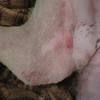Table of Contents
What You Need to Know | Where to Start | Match Dog Skin Symptoms To The Cause | Common Causes of Dog Skin Conditions
Diagnosis | Dog Skin Problems by Age | Dog Skin Diseases By Body Location | Skin Issues by Breed | Dog Skin Treatment
Ask a Question, Learn, & Advice From Our Vet | Free Brochures on Common Dog Skin Issues
Introduction:
"There is a long list of canine skin diseases and conditions that need to be considered before diagnosing the actual problem (see below for pictures and descriptions). If your dog is suffering from mild discomfort, then home treatment such as medicated shampoo therapy to eliminate itch and scratching is worth a try along with home remedies to boost immune system and manage the skin problem.
If dog skin itch or scratching causes redness, hair loss (alopecia), matting of hair or an interruption of your dog's normal routine, such as stopping in the middle of play to chew on the skin, then it's smart to visit a veterinarian for a definitive diagnosis and prescription medication. Puppies should always be diagnosed by a veterinarian since a dull coat and hair might indicate a case of dog worms.
Demodicosis mange is also seen in puppies just after being born. For adult dogs, diagnosis of dog skin diseases are based on the appearance of the skin and if any other symptoms exist. Flea allergy is the leading cause of problems, and is often present even when there are no signs of fleas in the home. Similarly, lice infestation can cause matting of hair, small wounds since there are two types of lice, i.e., chewing and blood-sucking lice.
Mild skin allergy is caused by contact, ingestion, injection or inhalation of an allergen. Symptoms include itch, rash or hives. In very rare cases a dog is hypersensitive, resulting in a reaction that could progress to anaphylactic shock (heart collapse and/or trouble breathing). These more acute cases are rare. Mild allergy is treated with one time or multiple doses of the prescription medication Diphenhydramine. Studies now show that the addition of a steroid is not necessary(16), however see your Vet for a specific diagnosis and treatment recommendation."
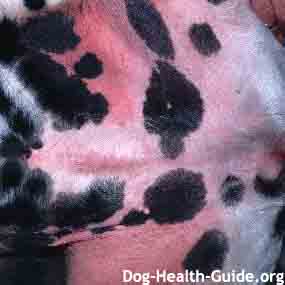 Dog Skin Problem Picture
Dog Skin Problem PictureDog Skin Allergy
Source: WSU Veterinary School
Start Here: How to Diagnose Dog Skin Problems
A veterinarian will attempt to narrow the list of possible causes by taking a thorough history along with a physical exam and some diagnostic lab tests. Dog flea allergy is the leading cause of skin problems, followed by other types of allergies such as environmental dog allergies (atopy) and dog food allergy.
Mange, a parasitic condition that causes patches of baldness, is the next leading cause and is primarily evident in puppies.
Other symptoms which accompany dog skin problems such as severe hair loss and excessive panting could indicate an underlying disorder such as an endocrine disease such as hyperadrenocorticism or Cushing's Disease. Treatment for dog skin conditions involve keeping the skin clean and treating the underlying as well as secondary cause such as bacterial infection or parasites.
Primary vs. Secondary Canine Skin Problems
Your vet will try and determine if a dog skin problem is primary or secondary. Primary skin lesions are caused by a specific disease. Secondary dog skin issues occur when a disease progresses or from a self-injury such as itching or scratching as is common with dog skin allergy. Secondary dog skin problems can also be a result of bacterial infections.
Identifying canine skin diseases and conditions can be difficult since there are many causes. The key to understanding which condition your dog is suffering from is to do your best to match the characteristics of each cause with the symptoms exhibited by your dog.
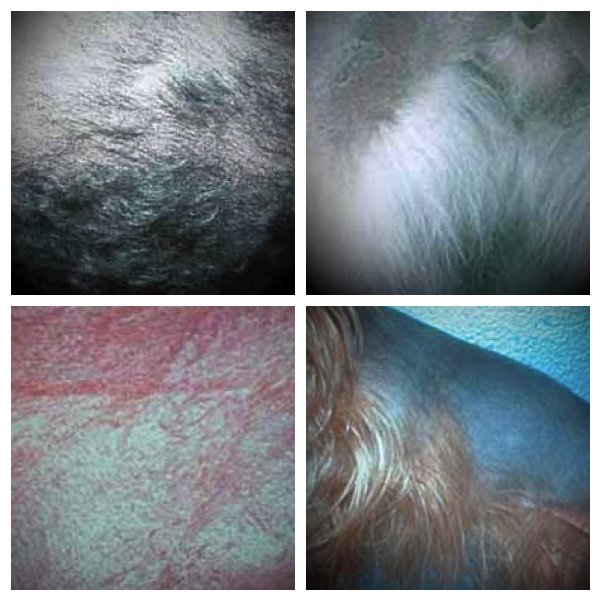 Dog Skin Problems Photos (top left to right): Alopecia due to follicular dysplasia, Castration-responsive dermatosis, Pattern alopecia on ear, Color dilution alopecia.
Dog Skin Problems Photos (top left to right): Alopecia due to follicular dysplasia, Castration-responsive dermatosis, Pattern alopecia on ear, Color dilution alopecia.Symptoms and Causes of Dog Skin Diseases
Canine skin conditions vary based on shape of the lesions and condition of the skin such as crusts, scars, ulcers, or scales, and the dogs behavior such as itching. It also depends on the location of these lesions or symptoms on body. The following table describes common symptoms and causes.
|
Symptom |
Possible Cause |
|
Abnormally colored skin (macules) |
Macules are circular flat areas up to 1 cm in diameter.
|
|
Alopecia (hair loss): occurs in four patterns -
Other terms include:
|
Most conditions that involve canine hair loss that occurs spontaneously (spontaneous alopecia) are primarily caused by a hormonal disturbance (malfunction of endocrine system) such as hypothyroidism. Other causes are folliculitis which is causes by inflammation of the hair follicle due to canine ringworm or a bacterial infection. Often, a cause cannot be determined. In puppies it can be caused by a hereditary or congenital defect, parasites, bacterial (impetigo), fungal infection (dermatophytosis - also called ringworm) or in older dogs canine sterile granulomatous dermatitis or lymphadenitis. Patchy hair loss on the head and face is a symptom of mange. Patches of dog hair loss can also indicate ringworm or allergy. The secondary cause of dog hair loss is when the dog bites, rubs, scratches, chews or is groomed excessively. |
|
Black Skin, Black Crusty Skin and Hperpigmentation 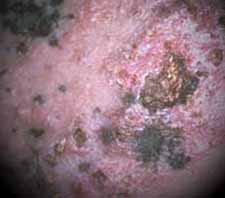 Dog Skin Problems Due to Pituatary Dependent Hyperadrenocorticism Dog Skin Problems Due to Pituatary Dependent Hyperadrenocorticism |
Hyperpigmentation occurs when the skin has too much of pigmentation, resulting in black dog skin spots. Causes of dog black skin spots include:
If the black skin spots become black scabs on dog or crusts, it is a symptom of a condition call Alopecia X or Cushing's Disease which is a problem associated with adrenal glands producing certain hormones in excessive quantities. Cushing's disease is also called Hyperadrenocorticism. |
|
Symptom |
Possible Cause |
|
Seborrhea refers to scaling skin which occurs when skin particles accumulate on the outer layer of the skin. Dog seborrhea sicca refers to dog dandruff, while greasy or oily skin is referred to as seborrhea oleosa. Canine seborrhea is caused by allergy, hormonal problems, bacterial infections, fungus, and tumors. Seborrhea can also cause scars, bumps and pimples on the skin. |
|
A dry, dull-looking coat along with severe hair loss, excessive panting, a distended abdomen, a reduction of muscle mass and thin/frail skin can indicate some type of underlying disease such as hyperadrenocorticism (Cushing's Disease) . Be sure to mention changes in coat condition as this is an indicator of something going on in your dog's body. It can also be a sign of poor nutrition. |
|
Foot and Nail Problems |
Dog foot and nail problems are a challenge to treat. They are classified into 4 groups:
|
|
Hot Spots (acute moist dermatitis) |
Caused by the removal of a superficial layer of skin due to scratching or biting. The condition is characterized by extreme discomfort, thus excessive itchiness or pruritis. |
|
Symptom |
Possible Cause |
|
Itching and Scratching, No Other Symptoms |
If the skin condition is limited to dog skin itch and scratching, then the first step is to suspect the beginning of a flea infestation. It's easy to miss fleas when inspecting your dog's hair, so don't be surprised if this is the cause. If fleas are not found after combing your dog with a flea comb, consider allergy as a possible cause. For mild conditions, ask your vet about using an antihistamine (for example diphenhydramine). You can also bring your dog some relief with a dog colloidal oatmeal shampoo. Avoid any product that is medicated at first, since these may cause additional irritation. Other possible causes after fleas are ruled out are environmental allergies (called atopy), food allergy and demodectic dog mange. Mange is caused by mites and is usually seen in puppies. Symptoms include bald patches and is diagnosed by a skin scraping in the Vet's office. |
|
Rash (Erythema) |
When a dog's skin has a rash or is red in color and is comprised of pustules (small, pus-filled blister like sores on skin), papules (small, red circular dog skin pimples less than 1 cm in diameter) and macules (discoloured skin spots), it implies that the problem is either of following conditions, thus requires detailed examination and even lab-testing before a conclusive diagnosis. However, use of natural remedies can help relieving the symptoms:
|
|
Itch, Redness and Pus |
In general, if your dog is suffering from skin itch, and if skin lesions are red in color and oozing pus, and are accompanied by hair loss, a trip to the veterinarian is needed as the condition is probably beyond your ability to control the problem with over the counter medications. In this case a dog skin infection has probably taken hold, requiring antibiotics and possibly short term steroid use for inflammation. |
|
Dog pimples or acne can have multiple causes including but not limited to skin tumors, allergy, infection (fungal, bacterial), fleas and mites. Some dogs can get acne with pimples around the mouth and chin. Use a dab of human benzoyl peroxide to see if the condition gets better. Dog skin pimples (papules less than 1 cm in diameter) are typically caused by:
|
|
Symptoms |
Possible Cause |
|
Red spots on dog skin with a central yellow sac of pus (pustules) |
Pustules are most commonly seen with a bacterial skin infection. Causes include:
|
|
If you see a dog skin lump do not automatically assume that is skin cancer. There are many "benign" causes of lumps or bumps such as a non-cancerous cyst, insect bite, an abscess or a benign lipoma (fat accumulated under the skin.)
Dog skin tags can look like a tumor, but usually are benign and will not cause any harm. The tag itself differs from a wart is that they are connected to the skin with a thin base. They are often similar in color to the skin and can sometimes be moved a bit with the fingers. In most cases dog skin tags can be left alone unless there is a cosmetic reason or the size of it becomes problem and requires removal. Another reason for removal is when you have a dog that licks or scratches the area, allowing irritation and infection to take hold. |
|
Pemphigus (skin pustles and crusts) |
This is an immune system disorder where the dog's body (immune system) mistakenly attacks the substance that holds skin cells together. The result is the skin literally coming apart, resulting in skin pustules and crusts, particularly around the bridge of the nose and feet. Symptoms include painful skin that is very red and crusty in appearance. Commonly effected areas of immune mediated dog skin diseases are at the ear margins, lips and nasal area. Canine lupus is another immune system related disorder with similar symptoms. |
|
There are many possible causes for dog skin odor. If the problems only occur during one time of year, then seasonal allergies are probably the cause. Bacterial and fungal Infections such as yeast can also trigger a smell, with the problem being corrected after treatment with a medicated shampoo (you can try this first) and antibiotics if needed. Other potential issues include seborrhea (condition that affects scalp and causes scaly patches and inflammed skin along with severe dandruff) which also can be addressed with a shampoo. If shampoos for infection or for seborrhea not work, then visit a veterinarian for a combination of topical and antibiotic treatment. |
|
Dogs that scratch the face, feet ,ears and arm pits usually have some form of inhalant allergy. Dog flea allergy causes dogs to scratch or lick the tail, back, groin and thigh. |
|
Red, irritated looking skin is a non-specific symptom and can be associated with any number of disorders such as mange or immune-mediated disorders (lupus, pemphigus) |
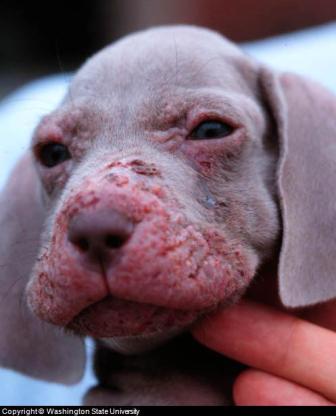 Juvenile Pyoderma, a Puppy Skin Disorder Causes Pimples on the Face
Juvenile Pyoderma, a Puppy Skin Disorder Causes Pimples on the FacePhoto Credit: Washington State University
|
Symptoms |
Possible Cause |
|
Scabs or Crusts |
Dog skin crusts or dog skin condition scabs are caused by the build up of pus or skin scaling due to skin diseases such as the immune-mediated disease canine pyoderma (pus filled bumps caused by bacterial infection). Crusts on the ear margins can be caused by mange. In Juvenile Pyoderma in puppies the sores form on the top of the muzzle and spread to the rest of the face. |
|
Scratches on Rear End |
Scratching near the tail could be caused by dog scooting on the ground due to a full anal gland. |
|
Parasites (fleas, mites, lice), poor grooming, dog skin infection (bacterial pyoderma, fungal), endocrine diseases, skin or hair follicle disorders disorders such as seborrhea, medication side effects (from corticosteroids) and allergy. It is rare for a sore or lesion to appear without another underlying condition such as allergy. |
|
Skin Scaling (dog skin dandruff) |
When the outside layer of the skin is shed, it is usually not seen on the skin and coat. Some conditions cause the flakes to accumulate. Seborrhohea is a condition that refers to scaling and dry skin along with stub-born dandruff. On the other hand, if the skin is very greasy it is called seborrhoea oleosa. Hyperkeratosis is a condition where the skin thickens, usually on the nose or the footpads. |
|
Symptoms |
Possible Cause |
|
Thick Dog Skin |
If you see a change in dog skin thickness, it can be caused by thickening of the skin or inflammation. Causes of dog skin thickness include:
|
|
Thinning Dog Skin (cutaneous atrophy) |
Dog skin that is thinning can be due to hyperadrenocorticism or Cushing's disease. Skin that suffers from cutaneous atrophy is easily wrinkled and is less elastic. It can also occur in dogs where glucocorticoids are applied as an injection or cream. |
|
Warts (Canine papillomatosis) |
Warts (papillomavirus) are non-cancerous - benign contagious dog skin pumps. They are transmitted via indirect and direct contact. Warts start as small papules and become larger to become small, cauliflower warts. They are found on the conjnctivae (eyes), buccal mucosa (lining of the cheeks and mouth), gums, tongue and lips. The most common type are oral warts that form in the oral cavity. Warts in other places are dark, slightly raised papules and plaques. They rarely become cancerous.(9) |
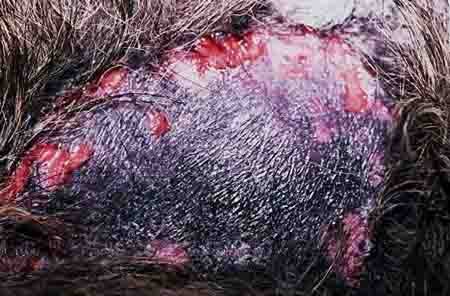 Dog Skin Bumps - Pictured: Dog Sores on German Shepard from Deep Pyoderma
Dog Skin Bumps - Pictured: Dog Sores on German Shepard from Deep PyodermaSource: Washington State University, Dr. Candace Sousa, Veterinary Specialist
Common Causes of Canine Skin Disease
Flea allergy dermatitis, environmental and food allergies are the leading causes of to dog skin lesions and rashes. Even if you don't find any fleas on your dog, they are skilled at hiding, with even a few able to cause a problem in allergic dogs. Symptoms are usually in the form of raised red bumps known as hives. They are itchy and will cause your dog to scratch. Excessive scratching may break the skin, leading to infection.
If no infection occurs, hives will usually go away on their own once exposure to the allergen is removed. If infection develops, however, medical treatment will be needed. See your vet if your dog has sores that don’t go away in a few days, or sores that ooze anything yellowish in color. He may need antibiotics.
Allergies
Allergy is a common cause of canine skin disease. The skin is the largest organ in the dog's body and is exposed to environmental influences such as allergens. Types of dog skin allergy include:
- Atopic Dermatitis (allergen that is inhaled causing a hypersensitivity reaction, most common cause).
- Food Allergy
- Flea Allergy
- Skin Allergy
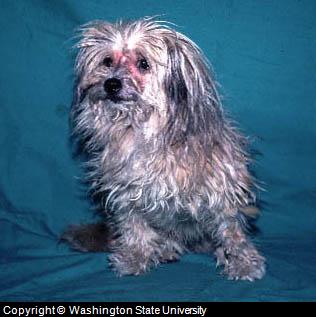 Lhasa Apso with Atopic Dermatitis
Lhasa Apso with Atopic DermatitisAtopic Dermatitis
Atopic dermatitis is a reaction to airborne allergens such as powder mites, weeks and tree pollen. It is not clear why the reaction occurs, although it is believed that there is some genetic predisposition among certain breeds(2):
- American Staffordshire Terrier
- Boston Terrier
- Boxer
- Bull Terrier
- Cairn Terrier
- Dalmatian
- English Bulldog
- German Shepherd
- Fox Terrier
- French Bulldog
- Golden Retriever
- Shar Pei
- Shih Tzu
- West Highland White Terrier
Triggers include air pollution, excess hygiene or stress. Allergens enter the body by swallowing, skin contact and by breathing them in.
Symptoms of atopic dermatitis are skin redness (erythema) and itch (puritus) and are usually on the abdomen, feet and face. Scratching can cause additional dog skin problems such as infection.
Treatment of atopic dermatitis skin problems on dogs starts with bathing since it helps to remove any surface allergens. The selection of shampoo should be based on what you are trying to achieve:
- Bacterial or Fungal Infection: Medicated shampoo can address infection or fungal overgrowth.
- Anti-itch: For itchy dogs, consider an anti-itch formulation that contains calming elements such as oatmeal or essential fatty acids such as All Natural Anti-Itch Shampoo.
- Anti-seborrheic shampoo: For dogs that have scaling or seborrhea (dandruff) in addition to the dermatitis. Look for a shampoo such as Duoxo with ingredients such as zinc salts, selenium disulphide, salicylic acid, sulfur or coal tar.
The veterinarian might also recommend a hypoallergenic diet that is formulated for skin and coat health. New products have been introduced that help to improve the skin layer. This includes:
- Phytosphingosin: Helps to improve the lipid composition of the skin. Found in Duoxo spray.
- Topical Essential Fatty Acids: An essential fatty acid spray can help to improve skin barrier function, reduce water loss and improve the hydro-lipidic composition of the skin.
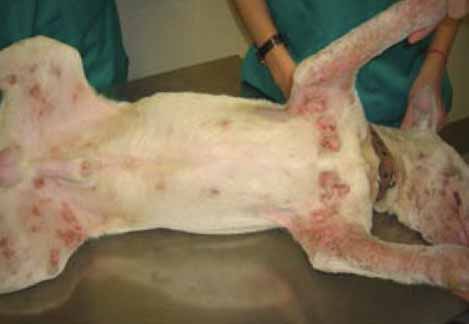 Dog Skin Allergies: Atopic Dermatitis on Abdomen and Legs
Dog Skin Allergies: Atopic Dermatitis on Abdomen and LegsFood Allergy Dermatitis
Food allergy in dogs causes itching on the ears and skin a few minutes, hours or even weeks (usually 24 to 72 hours)(3) after consuming an allergen. Food allergy may also make a dog susceptible to bacterial skin infection. The condition can be accompanied by nausea, increased number of bowel movements, diarrhea or vomiting.
Ingredients that commonly cause food allergy in dogs includes:
- beef
- chicken
- corn
- soy
- wheat
- dairy
The condition is diagnosed by providing a hypoallergenic diet or elimination diet (diet of just the basics) and then seeing improvement.
Avoid treats when on this diet as they are often the cause or a cause of the dog skin problem.
Flea Allergy Dermatitis (FAD)
Flea allergy is a condition that pet parents tend to deny, even when the veterinarian makes that the diagnosis. Reasons for dogs getting fleas include:
- Dogs that come in contact with untreated animals.
- Lack of consistent treatment.
- Substitution of less effective and cheaper store bought spot-ons instead of prescription grade products.(10)
Symptoms of flea allergy dermatitis include:
- Itch and scratching on the back half of the dog.
- Crusted skin bumps (papules) in the umbilical fold
- Skin lesions (crusted papule) that have a long duration
- Symptoms in the classic areas of the body; dog has scabs on back near tail base, lower back, rear part of the dog and inner thighs.
- Itchy skin nodules
Treatment for flea hypersensitivity involves the use of prescription products that disrupt the flea lifecycle and that kill adult fleas. Goals are to kill any existing fleas and the continued prevention of fleas through the use of spot-ons, collars and oral products. New spot-on prescription products are applied to the skin every 3 to 4 weeks and are highly effective. We do not believe that over-the-counter products from pet stores provide the same level of residual activity or safety.
Dog Mange
There are two types of dog skin conditions referred to as mange, demodectic and sarcoptic. It is caused by mites, which are generally microscopic and burrows in skin.
Demodectic Mange
Demodectic dog mange is usually mold and heals on its own in 6 to 8 weeks. It could last months in localized areas on the body.(6) Studies show little difference between treated and untreated dogs for small infections that are in one area of the body. For small localized cases, therapies include using benzoyl peroxide or mupirocin massaged into the skin.
Localized cases (limited areas on the body) could cause small red hairless spots. Other symptoms can include pimples, thick skin and pus, scaling around the eyes, mouth and front legs.
For generalized cases that are all over the body the medication Amitraz, which is a monoaminooxidase inhibitor, is prescribed. It is a topical that is applied every 2 weeks.
90% of cases can be cured, but can take up to 12 months. To ensure progress is being made a veterinarian may request repeat office visits very month. Many dogs with demodectic mange also get a bacterial skin infection. For this reason an antibacterial shampoo can help to address any skin crusts.
Sarcoptic Mange
Sarcoptic dog mange (scabies) in dogs is caused by mites. Symptoms include extreme itch, papules, scales and crusts.
The condition is diagnosed by a skin scraping, although this form of diagnosis is only positive in 30% to 50% of dogs with the condition.(7)
Treatment is with parasiticidal drugs that are administered every 2 to 3 weeks such as as a Selamectin spot-on. Other medications are ivervectin or milbemycin ,but these cannot be used in Old English Sheep dogs or Collies.
Bacterial Skin Infections
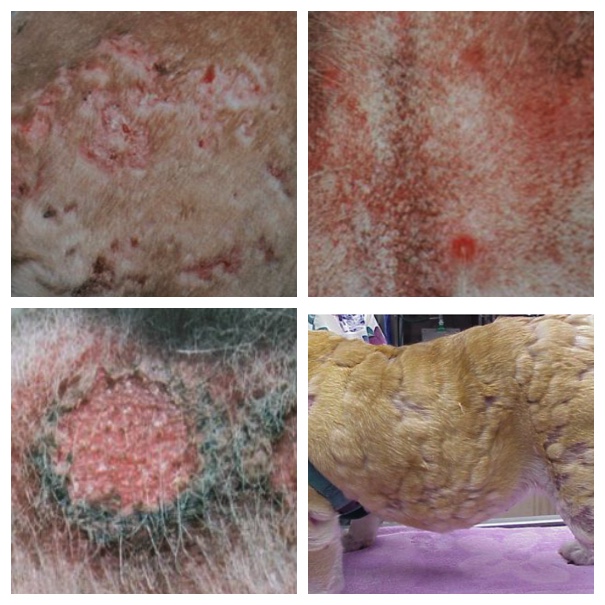 Dog Skin Infection Pictures (top: left to right): Deep pyoderma of the hair follicles - folliculitis, Superficial pyoderma on abdomen, Epidermal Collarette, Short-coated pyoderma
Dog Skin Infection Pictures (top: left to right): Deep pyoderma of the hair follicles - folliculitis, Superficial pyoderma on abdomen, Epidermal Collarette, Short-coated pyodermaDog bacterial skin infections are commonly referred to as:
- furuncolosis (penetrating or perforating follicular inflammation)
- folliculitis (superficial pyoderma)
- pyoderma (bacterial infection)
The infections are usually caused by the cover colonization of the skin by Staphyloccoccus. The bacteria is found on normal dog skin, but causes a problem when it grows beyond normal levels, frequently when another condition is suppressing the immune system.
This can be triggered by:
- Allergies
- Parasites
- Hormonal imbalance
- Kertatnization disorder
- Immunodeficiencies
- Metabolic disorders
Symptoms of a bacterial infection include:
- Rash
- Skin bumps
- Pustules (whiteheads)
- Comedones (blackheads)
Bacterial skin infections can look like Demodectic mange and Malassezia. For this reason, conditions like these need to be ruled out of a Veterinarian before reaching a definitive diagnosis.
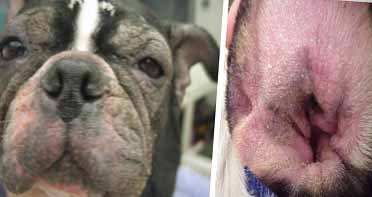 Dog Skin Rash Pictures (left to right): Melassezia (yeast infection) on face and ear.
Dog Skin Rash Pictures (left to right): Melassezia (yeast infection) on face and ear.Certain breeds such as Standard Poodles, Vizslas, Akitas and Samoyeds suffer from deep pyoderma or infection as a result of the condition sebaceous adenitis. Deep infections can also be helped by antibacterial benzoyl peroxide shampoo. The shampoo works by decreasing bacteria on the skin surface and by reducing the likelihood that an infection will return. Shampoos are used 2x per week.
All dogs suffering from skin infection will need to be re-evaluated for progress.
Folliculitis
Folliculitis is a bacterial skin infection and inflammation that causes mild to more severe skin itch. In most cases allergy is the underlying cause. Antibiotic therapy is frequently used to resolve the problem for a period of three weeks using a combination of oral and topical medications. If the condition is mild, a antibacterial shampoo or spray could be of help.
Pyoderma
Deep pyoderma refers to cases where there is a more severe skin infection. Most cases involve hair follicles that are infected with Staphylococcal infection. Symptoms include inflammation and redness. The condition is treated for 4 to 8 weeks with antibiotics. A form of deep pyoderma that affects the skin between dog toes is called Pododermatitis. Oral antibiotics are used to treat Pododermatitis.
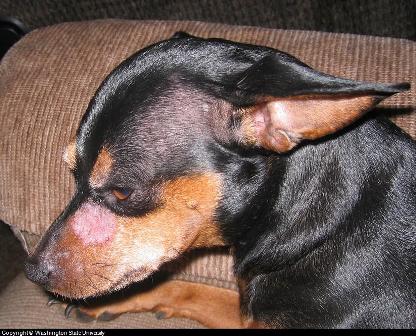 Dog Ringworm Skin Condition on Nose of 9 Year Old Miniature Pinscher
Dog Ringworm Skin Condition on Nose of 9 Year Old Miniature PinscherSource: Washington State University
Calluses
Calluses (thickened skin) form when a dog consistently lies on hard surfaces. The friction between the hard surface and the skin causes thickening to occur. The most common location is a dog elbow callus, but it could also form in other areas of the body.
Treatment involves replacement of the hard surface with a softer dog bed or blanket. You can use a soothing balm or butter, but do not do this unless you also solve the problem, which is replacing the hard surface with a softer one.
Fungal Skin Infections
Dog fungal infections are also called ringworm or Dermatophytosis. Typical symptoms are hair loss, crusting and scaling in a classic circular pattern. It is less common to see symptoms such as pain, itch or skin inflammation.(8)
It is common to see a dog fungal skin infection on the forelegs (can cause spots on the feet) and face since these come into contact with the environment.
The fungus can invade hair follicles, causing hair loss or feed on the keratin in the skin itself. Dogs with a compromised immune system are at greater risk of fungal infection.
The dog skin problem is diagnosed by examining the skin under a Wood's lamp or a fungal skin culture. Treatment involves the use of topicals (azoles) that contain Ketoconazole, Itraconazole, Fluconazole or other approved medications. A veterinarian might also recommend a medicated shampoo or the use of a Lime-suflur dip used 2x per week.
All items in a household with a fungal infection patient should be cleaned thoroughly.
Dog Skin Ulcers
A dog skin ulcer is a type of wound where there is a breach in skin continuity and it doesn't heal at it's own. Since dogs have relatively thin skin, diseases that damage the skin or self-trauma results in an ulcer.(15)
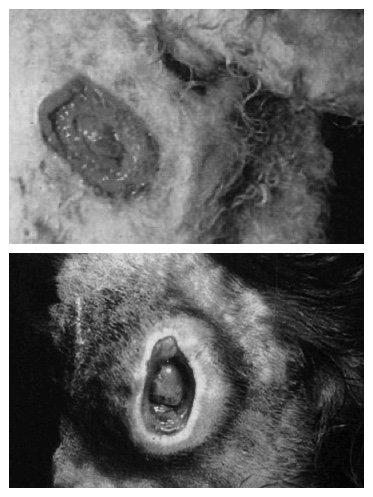 Dog Skin Ulcer Photos Caused by a Decubitus ulcer. These ulcers form over bony prominences.(1)
Dog Skin Ulcer Photos Caused by a Decubitus ulcer. These ulcers form over bony prominences.(1)There are several potential causes of skin ulcers in dogs. These skin problems in dogs include:
- Histoplasmosis: fungal infections characterized by ulceration and skin lesions.
- Leishmaniasis: nose ulcers
- Lymphoma: cancerous bumps
- Melanoma: dark lesions on older dogs
- Panniculitis: caused by skin injury or an autoimmune disorder
- Phaeohyphomycosis: contaminated wound
- Pyoderma: bacterial skin infection
- Pythosis: skin sores on legs
- Sebaceous Gland Tumors: tumors that form on the skin
- Spider bites: skin swelling after bite
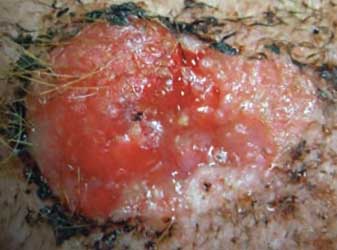 Sore on Dog Back Caused by a Squamous Cell Carcinoma (SCC), a condition related to sun exposure on the back.
Sore on Dog Back Caused by a Squamous Cell Carcinoma (SCC), a condition related to sun exposure on the back.Diagnosis of Canine Skin (Integumentary) Problems
Your vet will examine your dog's skin carefully as part of a complete examination. The exam will start with a thorough history since many dog skin disorders are more common in certain breeds and at specific ages. There is also a higher incidence of specific types of dog skin problems in some breeds.
In order to properly diagnose diseases and conditions canine skin, various tests may be needed along with physical examination. Tests might include:
- Examining skin under a special light (a woods light): this is done to check for certain fungal infections such as ringworm.
- Dog skin biopsy: in this test, a needle is used to remove cells from a lump to be examined by a pathologist. This can determine if a lump is cancerous or if it is just a cyst or wart.
- Blood tests: might be done to check for infections and certain nutrient deficiencies.
If you keep your dog clean and it continues to smell or have a greasy coat then your pet is probably suffering from parasites, seborrhea or a skin infection.
Dog Skin Problems by Age
Diseases and Conditions Canine Skin By Age |
|
|---|---|
| Dog Age | Common cause of Dog Skin Disorders |
| Under 6 months | Dog Mange
(Demodicosis) Canine Acne Juvenile Pyoderma (puss filled dog skin lumps) Ringworm (dermatophytosis) |
| Middle age dogs and young adults | Dog skin
allergy Hormonal imbalance Canine seborrhea (oily coat, crusts and scabs) |
| Older Senior Dogs | Hair loss
(alopecia) Dog Skin Tumors (neoplasms, cancer) |
Dog Skin Conditions by Body Location
Diseases and Conditions Canine Skin by Body Location and Symptoms |
|
|---|---|
|
Location on Dog Body Affected and Symptoms |
Dog Skin Disease that could be causing the problem and related treatment options |
|
Papules on the Small of the back, middle of the back thighs, groin, belly, tail base 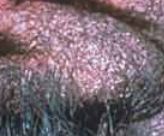 Dog Flea Bite
Hypersensitivity By:Washington
State University Dog Flea Bite
Hypersensitivity By:Washington
State University 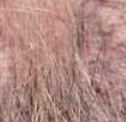 Dog Flea
Allergy PictureBy:Washington
State University Dog Flea
Allergy PictureBy:Washington
State University |
Flea bite hypersensitivity which is treated for itch and flea prevention. Kill fleas with a product such as a Herbal Flea Dip. |
|
Skin redness, hair loss, papules, skin crusts, all over body or in one area |
Dog Skin Infection (try anti-bacterial dog shampoo therapy), antibiotics |
|
Localized Demodicosis (dog mange) Skin redness, hair loss and
skin scaling on the dog face in less than 4 spots. |
Condition is caused by mites and is commonly referred to as dog mange. If in one area, may heal on tis own. For generalized mange consider a lime-sulfur dip such as Naturasil. |
|
Skin papule (raised area) on the ears, elbows, abdomen |
Sarcoptes mange or scabies using a lime-sulfur dip such as Naturasil. |
|
Papules on the face, ears and dog paws |
Fungal condition called Dermatophytosis treated with prescription medications that contain Grisseofulvin or Ketoconazole. Can benefit from anti-fungal dog shampoo therapy. |
|
Dog skin redness, discolored skin spot (called a macule), papules in areas where little or no hair is found, including fluid filled bumps in those areas, particularly in the dog's scrotum, chin, pelvis, paws, back of the abdomen |
Dog skin allergies or hypersensitivity treated with anti-inflammatory steroids or identification and avoidance of the environmental allergen (if possible) |
|
Uncontrolled cell growth resulting in a skin tumor or neoplasm
- referred to as a dog mast cell tumor 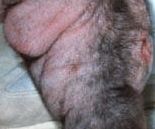 Dog Mast Cell TumorBy:WSU
Veterinary Dog Mast Cell TumorBy:WSU
Veterinary |
Removal with surgery |
Skin Issues in Dogs by Breed
Dog breed can also provide some clues when it comes to skin conditions, particularly in purebred dogs. Since these dogs are bred for certain traits, they also tend to pass on the same undesirable traits, including skin disease. Disease is also passed on genetically through line or in-breeding when a small stud population is used for breeding. Dog skin problems can be limited to one litter, one breed, or could be seen across certain breeds. Some of the more common breed specific canine skin diseases and conditions are described below:
Breed
Specific Diseases
and Conditions Canine Skin
|
||
| Breed |
Dog Skin Disease |
Treatment Options |
|---|---|---|
| Standard Poodles Miniature poodles Newfoundlands Belgian shepherd dogs Akitas Vizsla |
Canine Sebaceous adenitis:
This disease is characterized by follicular casts. The casts are skin
cell debris (keratinous debris) around the base of the hair shaft.
Other symptoms include dog hair loss (alopecia) on the top of the head,
back of the ears, at the tail and on the fore limbs. The condition is diagnosed by examining a skin biopsy. Any diagnosis needs to differentiate (confirm the presence of this condition) vs. conditions that have similar symptoms such as leishmaniasis (infection caused by protozoa), demodicosis (a type of mange) and superficial pyoderma (dog skin infection). Note that in the Vizsla only, a form of sebaceous adenitis, granulomatous sebaceous adenitis is found. Symptoms include localized hair loss (in a specific area on the body) and raised skin lesions, Canine Sebaceous Adenititis By:Washington State Unviversity
|
Prescription medications such as cyclosporine used and then decreased in dose as healing begins. In chronic cases, steroid therapy can help. Antibiotics are used to treat any skin infection (pyoderma)
|
| German shepherd Gordon setters English setters Large breed dogs |
Canine Symmetrical lupoid
onychodystrophy: This dog skin condition is characterized by the
loosening or shedding of the nails. The cause is unknown. Other symptoms include:
Diagnosis of canine symmetrical lupoid onychodystrophy is via a biopsy, skin culture and x-rays. The x-rays can also help to determine if the condition has caused any skin infections. Canine Symmetrical Lupoid Onychodystrophy Washington State University |
It is possible that on rare occasions the condition will heal
on its own. Treatment involves removing affected nails (anesthesia
required) and then bandaging the feet for 48 hours. Long term use
of antibiotics (doxycycline or cefalexin, niacinamide) are used to
control infection. |
| Labrador retrievers American bull terrier Staffordshire bull terriers Bulldogs |
Interdigital cystic folliculitis/furunculosis: Symptoms of
this dog skin problem are comedomes (keratin and sebum located
within the dilated orifice of a hair follicle) and As weight is placed on the paws, overgrowths occur. Dog Interdigital Cystic Folliculitis By: Washington State University |
The condition is treated with antibiotics and possibly topical
steroids. Most dogs with the condition require long term use of
antibiotics. |
Bull terriers Dalmatians Bassett hounds |
Solar induced canine actinic dermatitis and squamous cell carcinoma: this condition occurs in dogs from sun exposure. As you could expect, dogs that live in sunny climates have a higher incidence of the disease. Symptoms of actinic dermatitis appear in dog skin areas that are not protected by hair such as the abdomen and groin. Dog skin symptoms include:
Canine Solar induced actinic dermatitis By: Dog Health Guide |
Treatment involves the use of retinoids (vitamin A derivative), but only of some benefit. Some veterinarians see potential in the use of the topical
medication immune modulator imiquimod and the There is a risk of a dog relapsing if there is continued sun exposure. Dogs need to be re-examined every 6 months. If a lesion becomes cancerous (squamous cell carcinoma) then
surgical removal is required. |
Treatment
The treatment of canine skin diseases and conditions depends on the exact disease or condition. Treatment may involve oral or topical medication. It may also involve removal of any lumps or bumps from your dog's skin. If your pet's skin is affected by poor nutrition, treatment will involve making a correction in the diet.
There is a myth that baths are not good for dog skin diseases and conditions. This is not correct as bathing is an important part of just about every skin treatment. Shampoos are particularly effective on bacterial and fungal infections with a medicated bath 1 - 2 times per week. They also help to remove any allergens that are caught in the dog's coat.
If a bacterial has progressed deep into the skin then antibiotics are needed. You should also carefully look at your dogs diet and if it is causing any of the canine skin problems. Follow this link to understand Dog Food for skin or sensitive skin dog food.
For dry skin, If all other causes are ruled out, then you might want to consider using oil for dry dog skin.
You can also fill out the form below where you can ask a free canine skin question. Our veterinarian answers several questions a week.
Treating Mild Allergic Skin Reactions
Approximately 1.2% of visits to a veterinary emergency room are for what are called mild allergic reactions. Vets refer to these as Type 1 hypersensitivity reactions. These skin reactions are triggered when skin cells called basophils and mast cells and the immunoglobulin E antibodies on the surface of those cells come in contact with an allergen. The contact can occur via injection, inhalation, ingestion or direct contact.
When the cells come in contact with the allergen they release prostaglandins, leukotrienes and histamine. In turn you start to see an allergic reaction including:
- Urticaria (skin rash)
- Pruritus (itchy skin)
- Angioedema (skin swelling, hives)
- Anaphylaxis ( a chronic life threatening allergic reaction that could result in issues with heart function and heart collapse)
Treatment usually takes one of two forms:
- Use of the medication Diphenhydramine (2 mg/kg IM once)
- Oral diphnhydramine (2 mg/kg PO every 8 hours for 2 to 3 days)
While Doctors used to prescribe a corticosteroid during the first treatment, research now shows that this is not necessary and does not improve the outcome.(16)
Ask Our Vet A Question or Share Your Story
Have A Question about Your Dog's Skin Condition? Our Team Will Answer It for Free!
Do you have a question or comment? Share it!
Our editors will pick 1 question to answer each week. Please include your dog's age, breed, medical history, medications and if possible, a picture of the condition.
We will do our best to get back to you quickly (it depends on how many questions we receive each day). If you do require an immediate response we suggest using this online dog veterinary service that is available now.
Other Reader Dog Skin Related Questions and Vet Suggestions
Click below to see contributions from other visitors to this page...
My Dog Has A Rash 




We went to the veterinarian last week worried about this dog skin rash. They gave us a cream for it but it seemed to work for a little while but then …
Puppy Losing Hair and Scabs On Head 




I have a month and a half old German shepherd/miniature husky mix. The first picture is of her about two or three weeks ago and the second is of her today. …
Dog Skin Problem 




Reader Question: Dog Has Ongoing Skin Problem Under Tail
Breed: Rough Collie
Age: 4 years old
Medical History: Colitis controlled by high fiber …
Dog Nose Color Change 




Spayed one and a half year old 110 pound Great Pyrenees/Akbash mix with no health problems at all. Her nose seems to be changing from that typical solid …
My American Eskimo has developed Red Round Bumps with Scabs over Bumps 




Reader Question: What has caused my American Eskimo to have developed red round bumps with scabs?
My 10 year old American Eskimo just developed red …
Dog Skin Problem Gone Unanswered 




I have a 9 year old Pit Bull mix and he has had issues with skin problems for almost 4 years. I adopted him from the pound when he was about a year old. …
Red Itchy Dog Rash 




My pit bull is about 8 months old, male. He has this horrible worsening rash on his underside- irritated, but not dry or greasy, with continuous licking …
Dog Skin Rash Around Mouth and Lips 




Hi,
My female Labrador is just under 2 years old. She has developed a strange rash around her lips and mouth. She has been chewing a lot lately, but …
Dog Sprayed by Skunk 




My dog was sprayed by a skunk in the middle of the night. I think he was directly hit in the mouth and nose as he did not smell anywhere else but in that …
Peeling Dog Skin 




Reader Question: What Is Causing My Dog's Skin To Peel?
I noticed a few weeks ago that my family dog had a strange, raw patch of skin right between …
Canine Skin Rash After Giving Birth 




I have a french bulldog that just gave birth in December. Everything went great, but now she is having dog skin problems. She has a canine skin rash that's …
Dog Raw Skin and Hairless at Tail Base 




My dog has a raw area on her back where the tail meets her back. Hair is missing and she's constantly at it. Can you shed some light on the problem?
…
Smelly Dogs 




My treeing walker Coon Hound has a very red underbelly and red areas between the pads on his paws. His is not experiencing any itching.
He is an extremely …
Dog Ear Skin Problem 




Dog Ear Skin Problem Reader Question: I suddenly noticed many round patches of white scaly greasy feeling mater under the very long hair of my Porty's …
Infected Dog Wound 




Infected Dog Wound Reader Question: About a week ago my dog was out playing and scratched herself. (something she does all the time)I cleaned the scratch …
Red to Purple Color Skin Underarm Area 




Dog Skin Condition Reader Question: My 2 year old pit bull has red to purple skin color under his arms. There is no itching. The skin actually looks …
What are These Red Spots on my Dog's Leg Not rated yet
My dog keeps on itching and licking and biting his back leg I want to know what he has .....I am having trouble identifying what it could be ....
Editor …
Mystery Severe Dog Skin Infection Not rated yet
we think it started as a spider bite after a night eating out. He’s been to the vet and the ER. No one has ever seen anything like it, so it's still undiagnosed. …
Leg Skin Hardening in Senior Dog Not rated yet
My dog's skin is getting worse. it started on one leg now it spreading fast. She is 20 years old other wise in good health. Her one leg is hard the whole …
Calluses on Leg Due to Chronic Pressure Not rated yet
Nikki-Our blue beagle has had a scabby patch on her leg for a few years. The vet said it is common and is caused by her lying down and putting pressure …
Hole on My Dog's Back Not rated yet
my pekennesse maltese had a bump on her back and white stuff came out of it and now their is a hole on her back and losing hair around it.
Any suggestions? …
Puppy Bump Not rated yet
My 9 week old puppy has a scabbed bump on the end of his shaft on the left side. The scab came off but did not bleed so I put hydrogen Peroxide and Neosporin …
Pit Bull with Weird Lumps on Skin Not rated yet
These lumps change in placement size and amount, often. Sometimes it is worse than others. We brought her to our vet and were told to watch diet for process …
Dog Skin Scabs around Eyes and Mouth Not rated yet
Reader Question: What is cause of dog skin scabs around eyes and mouth?
My dog is perfectly healthy 1 and a half-year-old husky black lab border collie …
Causes of Dog Hair Loss Not rated yet
Reader Question on Possible Causes of Dog Hair Loss
Hi, my name is Francesca. My dog is a 7-year-old Pointer. When she was a puppy we treated her …
How to Treat a Recurrent Dog Skin Infection Not rated yet
Reader Question: Symptoms Returned After Treating a Dog Bacterial Skin Infection
My 9 year old Westie has had a skin problem develop over the last …
Lump on Dog Hip Not rated yet
Reader Question: Treatment for Lump on Dog Hip
My dog Bella (Bermise, border collie, 110 lbs, 9 years old) has had a hard lump the size of a plum …
Treatment for Dog Skin Pimples and Irritation Not rated yet
Reader Question: When I first bought my Shihtzu 4 months old, he was just cured from ear mites but had some red bumps like pimples on his tummy. …
How To Diagnose A Dog Skin Rash Not rated yet
Reader Question: Causes of Dog Skin Rash
My White German Shepard has a pinkish (might be from loss of hair, skin is pink/spotted), puffy, itchy area …
Skin Rash on Female Dog Not rated yet
I have a 5 month old St. Bernard pup. I just recently noticed she had brown scaly flakes on the insides of her hind legs. I washed it off and realized …
Puppy Hair Loss on Head Not rated yet
I have a month and a half old German Shepard/miniature husky mix. She was always normal and healthy until about a week ago or two ago. She started losing …
Canine Squatting Down Not rated yet
Reader Question: What Causes Dogs To Squat Down?
Our Irish Terrier has started squatting down as if scooting but receives regular de-worming treatment …
Dog Skin Irritation and Hair Loss Not rated yet
Reader Question: Canine is suffering from skin irritation and hair loss
Hello,
My daughter has a 6 year old Sheltie. In early September we noticed …
Causes of Chalky Dog Skin Growths Not rated yet
Reader Question: What could cause a chalky dog skin growth that snaps off.
Question: Hi, my male King Charles Cavelier aged 7 has something growing …
Yeast Infection on Dog Jaw Not rated yet
My 6 year old Golden Retriever has a wide, flat, leathery, sometimes raw patch underneath her jaw downwards for about six inches.
She frequently rubs …
Prednisone Did Not Help Dog Skin Problem Not rated yet
Reader Question Followed by Suggestions From Our Vet: How to Diagnose Dog Skin Problems?
My dog has dry scab like patches on his back and is always …
My Dog has Fleas Not rated yet
My sister has a white Lhasa Apso. Ever since he was a puppy his hair on his lower back is discolored. The color of his lower back is brownish pink. He …
Dog Stiff Skin Problem Not rated yet
My bluenose pittbull has a patch of stiff skin and the fur on it is lighter than the rest of his fur. He has skin allergies in the summer, but dosent seem …
Dgo Skin Tags Not rated yet
My almost 15 year old beagle mix, has developed several, what appear to be dog skin tags on her legs, and body. There are a few that she is now licking, …
Dog Red Itchy Rash on Underside Not rated yet
Reader Question: Dog Itchy Rash Treatment
My pit bull is about 8 months old, male. He has this horrible worsening dog rash on his underside- irritated, …
Diagnosis and Treatment of a Recurrent Dog Skin Infection Not rated yet
Reader Question: How do I treat and cure a recurrent dog skin infection?
My 3 yrs old Maltese has a recurrent dog skin infection since May this year. …
Hard Bump Under Dog Chin Not rated yet
My 11 year old white shepherd has a smooth, hard lump, about the size of a pinky fingertip, under her chin. I cannot see any discoloration.
She has …
Cyst Removal Not rated yet
Reader Question: How To Treat Dog Cyst
My 12 year old poodle has a cyst/lump on the right side of his chin. The vet noticed it but never indicated …
Cause of Dog Hair Loss Not rated yet
Reader Question: Cause of Dog Hair Loss
My dog recently had a large, but one normal wound on his rear end, near the tail. We treated the wound, but …
Doberman Losing Dog Skin Pigment Not rated yet
My dog is a white doberman, white below and fawn on top with blue eyes. He is a neutered male, approximately six years old, with a history of dog skin …
My Dog's Skin Problem Not rated yet
Reader Question on Dog Skin Problem Followed by Suggestion From Our Vet
We have a 6-year-old male Lab/Pitt Bull mix. Last year after he was at the kennel …
Raised Bumps on Dog Back Not rated yet
My dog has an area of raised bumps on his back that resemble scabs. They don't seem to bother him but I am curious as wto what they are. I don't have …
Treating Bumps On Dog Lips Not rated yet
Reader Question and Suggestions From Our Veterinarian
I have a mix pit/lab he's only 9 months old, but he has these bumps on his top and bottom lips. …
My Dog Is Losing Hair Not rated yet
Reader Question:
I just adopted a 7 month old lab. In the past few weeks I have been noticing that her hair has been thinning. She now has several …
Dog Losing Hair on Leg Not rated yet
I just got this dog from the pound and it looks like she has licked a spot under her back leg so much that her hair is gone and the skin is dark and looks …
Itchy Dog Skin Not rated yet
Our dog Bastardo is a Border Collie mix. His age is a rough estimate, we think he is around 12 or 13. The vet under estimated his age, we think, because …
Canine Dry Skin Not rated yet
My Sharpe has a canine dry skin condition. Can I treat him with Biotin, Vitamin E and Zinc?
Canine dry skin - Dog Health Guide editor suggestions …
Dog Red Skin Problem Not rated yet
Dog Red Skin Reader Question: I do not have any idea the dog type. He was given to us last week. He was very red on the underside of his body. Itching …
Dog Muzzle Scab Not rated yet
Dog Muzzle Scab Reader Question: My dog has sore skin on the underside of his muzzle. This keeps scabbing over then the process starts over again. He …
Brochures on Skin Disorders in Dogs
References for Skin Disease in Dogs
(1) Swaim SF, Henderson RA (1990) Small Animal Wound Management Lea and Febiger, Philadelpha, pp 52-86
(2) Skin and coat care of the atopic dog. Laura Navarro Combalia. Departamento de Patologia Animal. Facultad de Veterinaria. Universidad de Zaragoza. Clinica Veterinaria August. Zaragoza. October 2012.
(3) Food Allergy Dermatitis; S. Colombini Osborn; Southwest Veterinary Dermatology, 2006
(3) Washington State University
(4) Carmichael, L. Recent Advances In Canine Infectious Diseases
(5) Management Challenges in Canine Pyoderma
Peter J. Ihrke, VMD, Diplomate ACVD
(6) Treatment of Canine Generalized Demodicosis; R.S. Mueller, Faculty of Veterinary Medicine, Ludwig-Maximillians-University, Munich, Germany
(5) School of Veterinary Medicine, University of California,
David Scott, D. W., Miller, W. H., Griffin, C. E.Muller and Kirk’s Small Animal Dermatology
(6) Canine and Feline Demodicosis
Didler-Noel Carlotti Dr. vet DIP ECVD
Eysines (Bordeaux), France EU
(7) Sarcoptes, Demodex and Otodectes: Treatment Options, R.S. Mueller, Faculty of Veterinary Medicine, Lugwig-Maximillans-University, Munich, German
(8) Dermatophytosis: Still Underdiagnosed & Overdiagnosed. Dr. Peter J. Ihrke
(9) Viral Diseases of the Dog, Remo Lobetti, PHD, Internal medicine Braystron Veterinary Hospital
(10) A Standard of Care, Flea Allergy Dermatitis. Peter F. Ihrke, VMD, Diplomate ACVD, Professor of Dermatology, School fo Veterinary Medicine, University of California.
(11) Merck Veterinary Manual, Flea Allergy Dermatitis
(12) Canine Osteosarcomas
Alfred M. Legendre, DVM, MS DACVIM
College of Veterinary Medicine
University of Tennesse, Knoxville, TN
(13) Wandering Through the Autoimmune Dermatosis: Pemphigus Complex
Carlos Eduardo Larsson
(14) Sun-Induced Skin Lesions in Dogs
Alexander Werner, VMD, DACVD
Animal Dermatology Center
(15) Understanding the Language of the Skin, Peter Hill, BVSc, The Royal (Dick) School of Veterinary Studies
(16) Vet Emerg Crit Care (San Antonio). 2021;31(3):380-386







